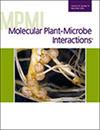求助PDF
{"title":"小麦酵母在田间多样性和效应变异方面存在局部差异。","authors":"Andrea Tobian Herreno, Pu Huang, Isabella Siepe, Remco Stam","doi":"10.1094/MPMI-01-25-0006-FI","DOIUrl":null,"url":null,"abstract":"<p><p><i>Zymoseptoria tritici</i> is a cosmopolitan hemibiotrophic wheat pathogen with a high mutation rate and a mixed reproduction system, with sexual and asexual cycles occurring within the same disease cycle. This leads to challenges in traditional farming management. For successful integrated pest management, especially for surveys of new aggressive lineages, it is critical to understand population diversity in the field. We look at whole-genome sequence data for three datasets to differentiate within field diversity in fields of similar size: one dataset from a newly sampled field population from the United Kingdom and two publicly available datasets from fields from the United States and Switzerland. This survey of genetic variation allows us to describe in detail how variable the field populations are and offers insight into the dynamics of the disease in a snapshot per field. Inspection of population structure and diversity features, such as minor allele frequency distribution and clonality, show no within-field structure, the most abundant single-nucleotide polymorphisms are present in low frequency, and European fields have higher clonality. Knowing that effectors play particularly important roles in (a)virulence, we specifically assess effector diversity characteristics. On a whole-genome scale, we can see separation of the populations at the regional scale, but we do not find such separation for the effectors. Moreover, we find that multiple effector haplotypes can be found interspersed within the field and even occur within what have been considered clonal isolates or isolates from a single lesion. Our analyses highlight that within-field <i>Z. tritici</i> genetic variation is higher than previously reported. Our finding that multiple effector haplotypes can be found within a single lesion might explain the large resistance gene-breaking potential of <i>Z. tritici</i>. [Formula: see text] Copyright © 2025 The Author(s). This is an open access article distributed under the CC BY-NC-ND 4.0 International license.</p>","PeriodicalId":19009,"journal":{"name":"Molecular Plant-microbe Interactions","volume":" ","pages":"385-399"},"PeriodicalIF":3.4000,"publicationDate":"2025-05-01","publicationTypes":"Journal Article","fieldsOfStudy":null,"isOpenAccess":false,"openAccessPdf":"","citationCount":"0","resultStr":"{\"title\":\"<i>Zymoseptoria tritici</i> Shows Local Differences in Within-Field Diversity and Effector Variation.\",\"authors\":\"Andrea Tobian Herreno, Pu Huang, Isabella Siepe, Remco Stam\",\"doi\":\"10.1094/MPMI-01-25-0006-FI\",\"DOIUrl\":null,\"url\":null,\"abstract\":\"<p><p><i>Zymoseptoria tritici</i> is a cosmopolitan hemibiotrophic wheat pathogen with a high mutation rate and a mixed reproduction system, with sexual and asexual cycles occurring within the same disease cycle. This leads to challenges in traditional farming management. For successful integrated pest management, especially for surveys of new aggressive lineages, it is critical to understand population diversity in the field. We look at whole-genome sequence data for three datasets to differentiate within field diversity in fields of similar size: one dataset from a newly sampled field population from the United Kingdom and two publicly available datasets from fields from the United States and Switzerland. This survey of genetic variation allows us to describe in detail how variable the field populations are and offers insight into the dynamics of the disease in a snapshot per field. Inspection of population structure and diversity features, such as minor allele frequency distribution and clonality, show no within-field structure, the most abundant single-nucleotide polymorphisms are present in low frequency, and European fields have higher clonality. Knowing that effectors play particularly important roles in (a)virulence, we specifically assess effector diversity characteristics. On a whole-genome scale, we can see separation of the populations at the regional scale, but we do not find such separation for the effectors. Moreover, we find that multiple effector haplotypes can be found interspersed within the field and even occur within what have been considered clonal isolates or isolates from a single lesion. Our analyses highlight that within-field <i>Z. tritici</i> genetic variation is higher than previously reported. Our finding that multiple effector haplotypes can be found within a single lesion might explain the large resistance gene-breaking potential of <i>Z. tritici</i>. [Formula: see text] Copyright © 2025 The Author(s). This is an open access article distributed under the CC BY-NC-ND 4.0 International license.</p>\",\"PeriodicalId\":19009,\"journal\":{\"name\":\"Molecular Plant-microbe Interactions\",\"volume\":\" \",\"pages\":\"385-399\"},\"PeriodicalIF\":3.4000,\"publicationDate\":\"2025-05-01\",\"publicationTypes\":\"Journal Article\",\"fieldsOfStudy\":null,\"isOpenAccess\":false,\"openAccessPdf\":\"\",\"citationCount\":\"0\",\"resultStr\":null,\"platform\":\"Semanticscholar\",\"paperid\":null,\"PeriodicalName\":\"Molecular Plant-microbe Interactions\",\"FirstCategoryId\":\"99\",\"ListUrlMain\":\"https://doi.org/10.1094/MPMI-01-25-0006-FI\",\"RegionNum\":3,\"RegionCategory\":\"生物学\",\"ArticlePicture\":[],\"TitleCN\":null,\"AbstractTextCN\":null,\"PMCID\":null,\"EPubDate\":\"2025/6/27 0:00:00\",\"PubModel\":\"Epub\",\"JCR\":\"Q2\",\"JCRName\":\"BIOCHEMISTRY & MOLECULAR BIOLOGY\",\"Score\":null,\"Total\":0}","platform":"Semanticscholar","paperid":null,"PeriodicalName":"Molecular Plant-microbe Interactions","FirstCategoryId":"99","ListUrlMain":"https://doi.org/10.1094/MPMI-01-25-0006-FI","RegionNum":3,"RegionCategory":"生物学","ArticlePicture":[],"TitleCN":null,"AbstractTextCN":null,"PMCID":null,"EPubDate":"2025/6/27 0:00:00","PubModel":"Epub","JCR":"Q2","JCRName":"BIOCHEMISTRY & MOLECULAR BIOLOGY","Score":null,"Total":0}
引用次数: 0
引用
批量引用

 求助内容:
求助内容: 应助结果提醒方式:
应助结果提醒方式:


